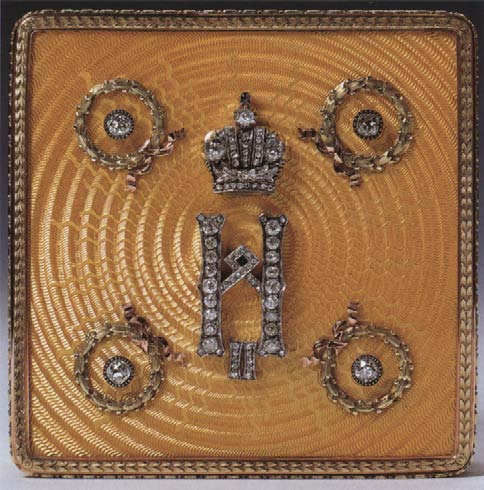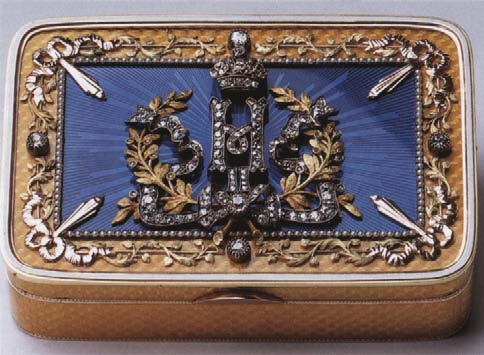THE NAME OF FABERGE is synonymous with luxury objects
and jewellery made to exacting standards from the
finest materials. It should be noted that while his work
was eclectic by nature, drawing on a wide range of design
sources, it encapsulated the style of a whole period at the end
of the nineteenth century and beginning of the early twentieth
century. Supported by Faberge’s international reputation,
this style proved deeply influential on goldsmiths and jewellers
based in Russia and encouraged others abroad to imitate
his products. He counted not only the Russian imperial and
British royal families as his best clients, but most of the
royal houses of Europe, along with aristocrats and wealthy
businessmen around the world. The importance of the British
royal family among Faberge’s clients has already been outlined
and their contribution to his success is evident, but they did
not confine their patronage to him. Similarly, the Russian imperial
family bought from other jewellers and goldsmiths, with
the result that objects by other makers were given as official
presents and in some instances entered the Royal Collection
as gifts (e.g. cat. 357). The works of art by other makers included
here provide a representative rather than a comprehensive
overview of both Russian and European competitors of Faberge
and give an insight into the acquisition of works in Faberge’s
style by members of the royal family.1
Although Gustav Faberge had begun to supply the
Imperial Cabinet in 1866, it was not until his son Carl received
the official tide of Supplier to the Court of His Imperial Majesty
Tsar Alexander III in 1885 that the firm became a major
supplier. Ten years later the death of Alexander III, followed
by the wedding and coronation of his heir, Nicholas n,
brought an overwhelming number of commissions to the jewellers
and goldsmiths of St Petersburg and Moscow. While
Faberge was awarded many of the most important commissions
and was eventually to become the most prolific royal
jeweller, there were several other firms that were already wellestablished
suppliers to the court.
The firm of Bolin was established by Carl Edvard
Bolin in St Petersburg in the 1830s and was the main supplier
of presentation orders and decorations to the court. From
1839 Bolin was appointed official jeweller to the imperial court
and the firm became the foremost jewellery business in
Russia. It was not until the 1890s that Faberge emerged as
Bolin’s main competitor. In spite of the originality of its
jewellery, much of which was in the art nouveau style, Bolin’s
firm took inspiration from Faberge for certain products. They
made fine gold and jewelled cigarette cases, but in general
their work lacked the refined elegance and sophistication
of Faberge’s designs. Given the longevity of Bolin’s firm
and the close links between the Russian and English royal families,
it is surprising to find that there are now no works by
Bolin in the Royal Collection. Queen Alexandra’s accounts
reveal that she made only one purchase from the firm, in January
1904, of a brooch costing £41;2 the brooch has not been
identified. Between 1912 and 1932 Queen Mary acquired the
only recorded Bolin piece to enter the Royal Collection, a
green enamel cigarette case very reminiscent of Faberge’s style.
Sadly, this object cannot now be traced.3
Another major competitor of Faberge, but not represented
in the Royal Collection, was the firm of Tillander.
Established by Alexander Tillander in St Petersburg in 1860,
from the 1890s the firm supplied the court with presentation
items such as brooches, cufflinks and tie-pins incorporating
the imperial emblems. The firm also made jewellery, miniature
Easter eggs, cigarette cases and picture frames – often in
the style of Faberge – and had a loyal following among the
nobility and industrial magnates of St Petersburg. In April
1911 the firm moved to 26 Nevsky Prospect, taking over
the premises formerly occupied by the court jeweller Hahn.
Tillander established a long-lasting and lucrative collaboration
with the Parisian jeweller Boucheron (also a competitor
of Faberge) after the assassination of the latter’s Moscow representatives
in 1911.
Karl August Hahn established his firm in St Petersburg
in 1873. In 1896 Hahn was commissioned by Tsar Nicholas
II to produce a diadem to be worn by Tsarina Alexandra Feodorovna
at her coronation. Hahn was subsequently appointed
supplier to the court and provided a range of objects including

box by
Faberge, 189&-
1908 (cat 145)
and (below) an
imperial presentation
box by
Faberge’s
competitor Hahn,
c. 1900 (cat. 354).
presentation boxes, cigarette cases and frames. Presentation
boxes were the traditional gift of the tsar to foreign high-ranking
dignitaries and a prestigious award to Russian subjects
of high merit. In general, Hahn’s presentation boxes, while
suitably opulent, are less up-to-date in style and the enamelling
incorporates a more limited colour palette than that
used by Faberge. A comparison of a presentation box by Hahn
(cat. 354) and one by Faberge (cat. 145) reveals the differences
between the two makers. The Hahn box is a litde old-fashioned
in shape and the guilloche enamelling, while finely executed,
shows a limited range of patterns. The Faberge box by
contrast is engraved with an exciting variety of patterns which
are almost three-dimensional in quality when seen through

the translucent yellow enamel. From 1892 Hahn employed as
a head workmaster the independent goldsmith and jeweller
Carl Blank, who became a partner in the business from 1911.
He produced work of a very high standard, most evident in
the objects that bear his mark in conjunction with that of Hahn.
The presentation cigarette case (cat. 355) is a fine example of
guilloche enamelling by Blank and compares well with Faberge’s
work, except for the large hinge and clumsy closing mechanism.
In spite of the quality of Blank’s enamel, it is generally
accepted that Faberge was producing the finest enamelling of
the period; no other maker approached, for example, the enormous
range of colours he produced. Although competitors,
the two firms sometimes collaborated. Hahn was responsible
for remounting Faberge’s presentation boxes, which were
occasionally returned to the Imperial Cabinet by their recipients
for a variety of reasons. The boxes would then be recycled
and presented to another recipient. This often involved removing
the portrait miniatures applied to them and replacing these
with the diamond-set cypher of the Tsar. After the death of
Dimitri Hahn (Karl August’s son), the business premises were
taken over by Tillander and Carl Blank returned to working
independently. According to Valentin Skurlov, Blank continued
to fulfil commissions for the Imperial Cabinet for orders
and decorations.4
The firm of Ovchinnikov was founded by Pavel
Ovchinnikov in Moscow in 1853. The business expanded
quickly to become a major supplier of silver and enamel objects
in the Pan-Slavic or Old Russian style. In 1873 Ovchinnikov
opened a branch of his business in St Petersburg, run
by his son Michael. Ovchinnikov’s success rested on his
cloisonne enamelling, which was widely recognised as being
of excellent quality. The firm became known in the rest of
Europe when its work was exhibited at the Exposition Universelle
in Paris in 1900. A set of salts in the Royal Collection
(cat. 364) demonstrates Ovchinnikov’s use of cloisonne enamelling
in jewel-like colours and is a good example of the firm’s
traditional Russian-style objects. Faberge was also producing
pieces in the Old Russian style from his Moscow workshop
from the 1890s onwards. These were mainly enamelled by
Feodor Riickert, who produced the highest-quality cloisonne
enamelling for the firm (see cat. 325). The date of acquisition
of the set of salts is unknown but they are likely to have
been acquired by King Edward VII and Queen Alexandra.
Queen Alexandra’s accounts reveal that she was a customer
of Ovchinnikov; she made purchases from the firm of jewellery
and ‘Russian objets d’art* between 1905 and 1911
amounting to £1,000, paid for from her miscellaneous account,
but none of these objects appears to survive in the Collection
today.5 King George V was also a customer of the firm, as
an invoice in the Royal Archives reveals. It appears that the
King purchased two cigarette cases, a squirrel and a rabbit
both in purpurine, two aquamarines and three amethysts in
July 1911. The invoice was issued from Paris, indicating
that Ovchinnikov made further selling trips to the Continent,
but the items were purchased in England.6
There are two works in the Royal Collection by the
St Petersburg goldsmith Ivan Britsin. Britsin’s workshop specialised
in the production of guilloche enamel objects in the
style of Faberge. The frame and seal included in this exhibition
(cat. 348 and 366) are enamelled in Britsin’s characteristically
limited palette of colours in which white featured heavily.
According to Von Habsburg, Britsin occasionally supplied
Faberge, whose mark appears in combination with his own on
a number of pieces.7 The frame and seal in the Royal Collection
were acquired at an unknown date by Queen Elizabeth.